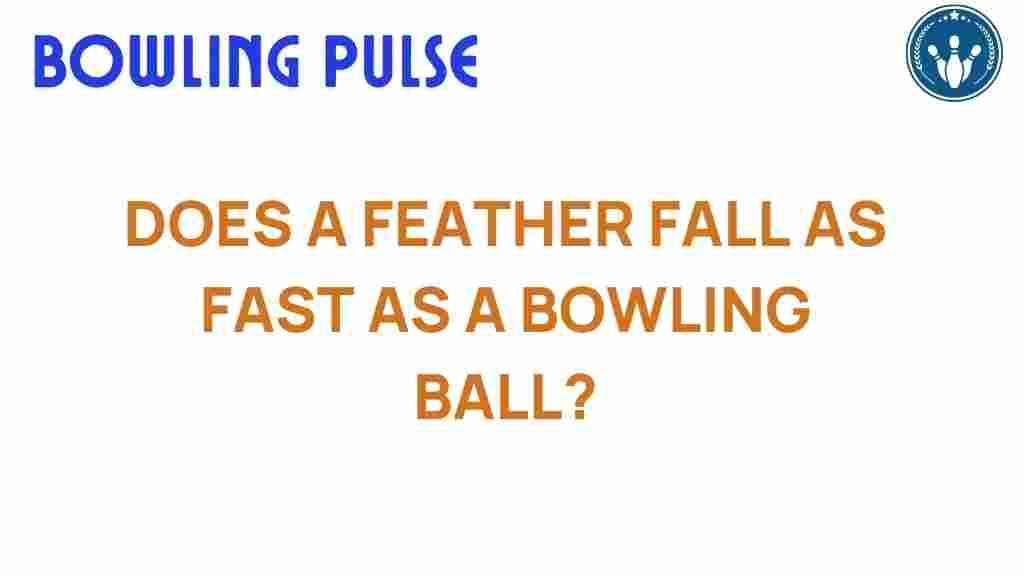The Surprising Science: Does a Feather Fall as Fast as a Bowling Ball?
When we think about falling objects, the image that often comes to mind is that of a feather gently floating down, contrasting sharply with a heavy bowling ball plummeting to the ground. This leads to an intriguing question: Does a feather fall as fast as a bowling ball? To answer this, we need to explore the fundamental principles of physics, gravity, and air resistance. In this article, we will delve into experiments that illustrate these concepts, sparking curiosity about how different objects behave under the influence of gravity.
Understanding Gravity and Free Fall
Gravity is a natural phenomenon that causes objects with mass to be attracted towards one another. On Earth, this force pulls objects downwards at an acceleration of approximately 9.81 meters per second squared (m/s²). This acceleration is constant, meaning that, in a vacuum where there is no air, all objects, regardless of their mass, will fall at the same rate. This phenomenon is known as free fall.
However, when we introduce air into the equation, things get more complicated. Air resistance, also known as drag, acts against the motion of an object as it falls. This force is dependent on several factors:
- Shape: The more aerodynamic an object is, the less air resistance it encounters.
- Surface Area: A larger surface area increases drag, slowing down the fall.
- Velocity: As an object falls faster, the air resistance increases until it balances the force of gravity, leading to terminal velocity.
The Feather vs. Bowling Ball Experiment
To demonstrate the differences in how a feather and a bowling ball fall, let’s conduct a simple experiment. Here’s how you can replicate this experiment at home:
Materials Needed
- A feather
- A bowling ball
- A tall building or a safe height from which to drop the objects
- Optional: A vacuum chamber (if available)
Step-by-Step Process
- Setup: Go to a high place where you can safely drop both the feather and the bowling ball.
- Drop the Bowling Ball: Hold the bowling ball at shoulder height and release it. Observe how quickly it falls to the ground.
- Drop the Feather: Now, drop the feather from the same height. Notice how slowly it descends compared to the bowling ball.
- Optional Vacuum Chamber: If you have access to a vacuum chamber, place both the feather and the bowling ball inside and remove the air. Drop them simultaneously and observe that they hit the ground at the same time.
Why Does This Happen?
The results of your experiment can be explained through the concepts of gravity and air resistance. The bowling ball, being much denser and having a smaller surface area relative to its mass, experiences far less relative air resistance compared to the feather. The feather, with its large surface area and lightweight structure, is significantly affected by air resistance, causing it to fall much slower.
In a vacuum, where air resistance is eliminated, both objects fall at the same rate due to gravity alone. This highlights a fundamental principle of physics: in the absence of air, all objects accelerate towards the Earth at the same rate, regardless of their mass. This was famously demonstrated by astronaut David Scott during the Apollo 15 mission when he dropped a hammer and a feather on the Moon, and they hit the ground simultaneously.
Exploring Air Resistance Further
Air resistance plays a critical role in how objects fall. Here are some additional points to consider:
- Terminal Velocity: As an object falls, it accelerates until the force of air resistance equals the force of gravity. At this point, it stops accelerating and continues to fall at a constant speed known as terminal velocity.
- Different Shapes and Sizes: Different objects will have different terminal velocities based on their shapes and sizes. For instance, a skydiver in a belly-to-earth position falls slower than in a head-down position.
- Real-World Examples: Feathered birds, parachutes, and even leaves all demonstrate how air resistance affects falling objects.
Troubleshooting Tips for Your Experiment
If your experiment doesn’t yield the expected results, consider the following troubleshooting tips:
- Ensure Consistent Drop Heights: Make sure both objects are dropped from the same height to get accurate results.
- Minimize Air Currents: Conduct the experiment indoors if possible to reduce the effects of wind or air movement.
- Use a Vacuum Chamber: If you have access to one, using a vacuum chamber will provide a clearer demonstration of free fall without air resistance.
Conclusion
In conclusion, the surprising science behind whether a feather falls as fast as a bowling ball is a fascinating exploration of physics, gravity, and air resistance. While the bowling ball descends quickly due to its mass and shape, the feather’s descent is drastically slowed by air resistance. This experiment serves as a reminder of the complexities of the natural world and how curiosity drives scientific discovery.
So, the next time you find yourself dropping a feather or a bowling ball, remember the principles of gravity and air resistance at play. The world of science offers endless opportunities to explore and learn. If you’re interested in further scientific experiments or concepts, visit this resource for more engaging ideas.
Let your curiosity lead you to new discoveries in physics and beyond!
This article is in the category Techniques and created by BowlingPulse Team
